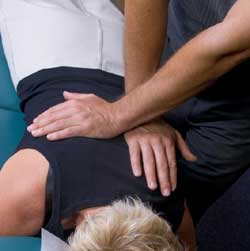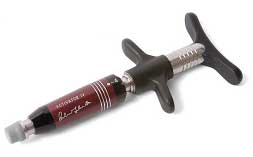Adjustment
 From between each bone in your back, a pair of spinal nerves exits and supplies each organ in your body with action potentials (impulses) from your brain and spinal cord. When a bone in your back gets "stuck" or "out of place", some local inflammation can occur. This inflammation can irritate the spinal nerves, causing pain both at the site of irritation as well as more distant areas, like arms or legs, hands or feet. A chiropractic adjustment helps to relieve this irritation by breaking up any adhesions in the surrounding tissue, and restore normal motion and integrity to the spine.
From between each bone in your back, a pair of spinal nerves exits and supplies each organ in your body with action potentials (impulses) from your brain and spinal cord. When a bone in your back gets "stuck" or "out of place", some local inflammation can occur. This inflammation can irritate the spinal nerves, causing pain both at the site of irritation as well as more distant areas, like arms or legs, hands or feet. A chiropractic adjustment helps to relieve this irritation by breaking up any adhesions in the surrounding tissue, and restore normal motion and integrity to the spine.
There are many types of adjustment that a chiropractor can use, depending on the area of the body involved, the body type of the patient, or simply patient preference. The most traditional adjustment, the kind that everybody thinks of when they hear the word, is performed much like the image to the right - a quick thrust applied by hand to an individual vertebra (back bone). Many times the patient will feel the bone move, and most often will hear or feel a slight "popping". The noise is normal; it's called a cavitation, and it's made by the formation and implosion of little bubbles within the joint, due to a change in pressure. But don't let the noise fool you - the goal of the adjustment isn't to hear a cavitation, it's to restore normal motion and integrity to the spine. This may be accomplished without a cavitation, so don't let its absence make you think that the adjustment was ineffective.
Sometimes, a chiropractor may add a drop to the adjustment. The adjustment is performed the same was as it is without the drop, but the drop allows the chiropractor to deliver it with much more speed, while using less force. Some people prefer to be adjusted with a drop because of the lighter touch. Others don't like the sound of a cavitation, and the sound of the table dropping masks this sound.
 Another method for adjusting is with the use of an instrument. Instrument-assisted adjusting was developed by Arlan Fuhr, who came up with a device called the Activator® (pictured at left). The Activator® can deliver a precise, low force impact to a vertebra, and feels like a light tapping. Many patients like the Activator® because of the extremely low force, and the rarity of a cavitation.
Another method for adjusting is with the use of an instrument. Instrument-assisted adjusting was developed by Arlan Fuhr, who came up with a device called the Activator® (pictured at left). The Activator® can deliver a precise, low force impact to a vertebra, and feels like a light tapping. Many patients like the Activator® because of the extremely low force, and the rarity of a cavitation.

